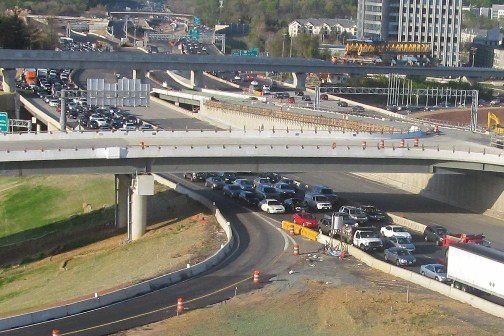 Commuters have long been awaiting the new Mega-Project 495 Express Lanes completion since the merits of the project were first announced in 2004. If you have been living under a local news rock over the past decade, essentially the new lanes are a congestion pricing system that based on the amount of traffic at any given time will charge a corresponding fee per mile to either attract or reduce users.
Commuters have long been awaiting the new Mega-Project 495 Express Lanes completion since the merits of the project were first announced in 2004. If you have been living under a local news rock over the past decade, essentially the new lanes are a congestion pricing system that based on the amount of traffic at any given time will charge a corresponding fee per mile to either attract or reduce users.
The concept has benefits;
- The new lanes were built for essentially nothing where as in the past it would have drawn upon a limited source of transportation funding, thereby reducing the availability of funds for other projects.
- The new lanes have the benefit of also serving as pseudo BRT (Bus Rapid Transit) because Fairfax Connector/Virginia Railway Express/WMATA buses will be able to use the lanes which are assured by Fluor to operate at all times above 45 mph.
- The new lanes will draw some users from the existing free lanes and reduce some congestion on 495.
The concept has some negatives too;
- The new lanes required extensive new infrastructure in the connecting communities that weren’t part of the Fluor Private-Public partnership including local road widenings to support the new anticipated traffic as well as future upgrades that will be necessary.
- The new lanes have created an even greater chasm in some neighborhoods, like Tysons, impeding all forms of transportation except for vehicles. Roads like Jones Branch Drive and Westpark which previously had acceptable access to pedestrians will now be enclosed by highway ramp entrances which are difficult to cross and prioritize vehicle through put over pedestrian safety.
- The effectiveness of the congestion relief is highly variable in other jurisdictions around the Country that have implemented this infrastructure. In some cities like Atlanta and Seattle the new congestion priced lanes have been either underused or ineffective and in some cases can actually induce more traffic on the original lanes by providing commuters a sense of a secondary option that few will use.
Over the next month we will find out the effectiveness of traffic congestion in the short term from the new project. Over the next several years we will find out if it was a net benefit or detriment to our region. Many proponents point to the benefit it provided to L.A. (a car oriented affluent city by all measures) though the long term effect on business in downtown has yet to be understood.
Some smart growth advocates are even divided on the subject matter, citing the aggressive congestion pricing in London and that city’s revitalization that has happened in its urban core due to the subsequent reduction in traffic. Unfortunately, any in depth review of London’s system would show that the key was to remove all entry points from escape and creating a “zone of congestion pricing”. Opponents of HOT lanes point to several other implementations that have shown that traffic will simply be pushed from one spot to another as commuters find their own path of least resistance. Without all of the region inside the beltway constrained with congestion pricing the project will likely fall somewhere in between LA and Atlanta over the next few years… it is no shock that both of those cities are perennially in the top 5 worst commutes list. It may however come as a shock to find out that those two cities are also in the top 5 list for the most paved surface per capita, making it quite clear that the amount of road has very little to do with the ability to move people.
The real question isn’t how much will traffic improve with the new Lexus lanes, but how long will it last given current land use policy and whether the benefits of the project will outweigh the detriment it will cause to divided communities in its shadow.
[formidable id=5]
